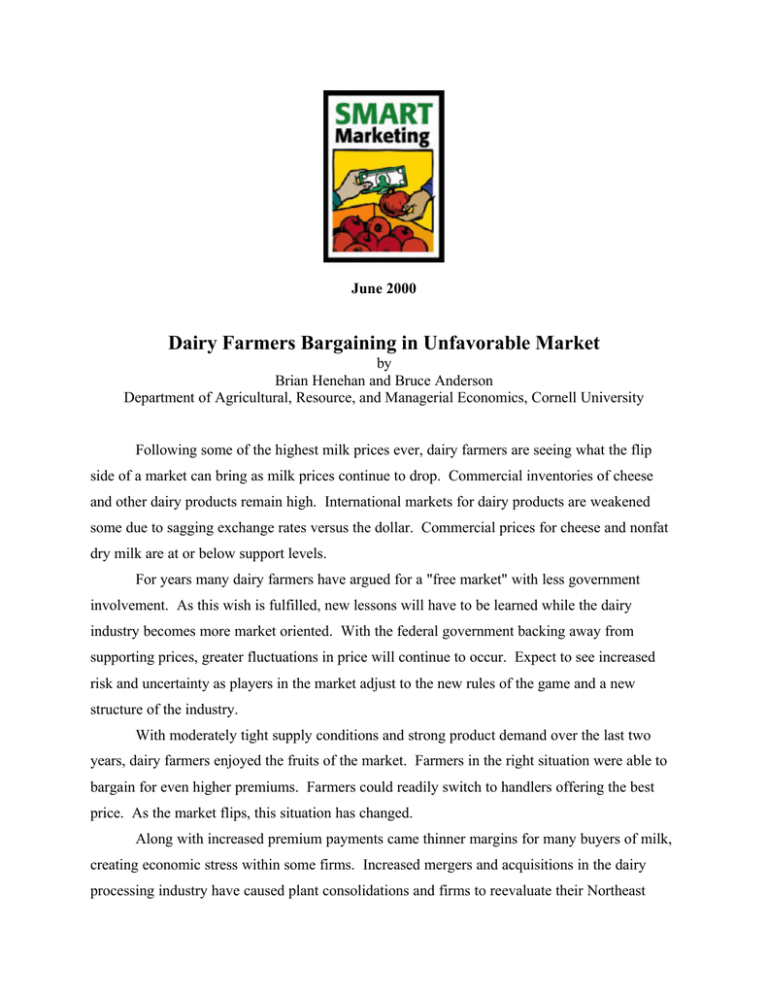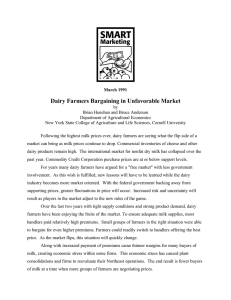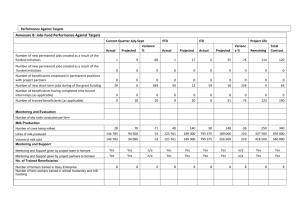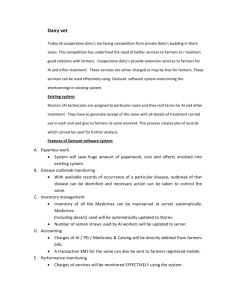Dairy Farmers Bargaining in Unfavorable Market
advertisement

June 2000 Dairy Farmers Bargaining in Unfavorable Market by Brian Henehan and Bruce Anderson Department of Agricultural, Resource, and Managerial Economics, Cornell University Following some of the highest milk prices ever, dairy farmers are seeing what the flip side of a market can bring as milk prices continue to drop. Commercial inventories of cheese and other dairy products remain high. International markets for dairy products are weakened some due to sagging exchange rates versus the dollar. Commercial prices for cheese and nonfat dry milk are at or below support levels. For years many dairy farmers have argued for a "free market" with less government involvement. As this wish is fulfilled, new lessons will have to be learned while the dairy industry becomes more market oriented. With the federal government backing away from supporting prices, greater fluctuations in price will continue to occur. Expect to see increased risk and uncertainty as players in the market adjust to the new rules of the game and a new structure of the industry. With moderately tight supply conditions and strong product demand over the last two years, dairy farmers enjoyed the fruits of the market. Farmers in the right situation were able to bargain for even higher premiums. Farmers could readily switch to handlers offering the best price. As the market flips, this situation has changed. Along with increased premium payments came thinner margins for many buyers of milk, creating economic stress within some firms. Increased mergers and acquisitions in the dairy processing industry have caused plant consolidations and firms to reevaluate their Northeast operations. The end result is fewer buyers of milk at a time when more and larger groups of farmers are negotiating prices. Federal order changes have resulted in a new component pricing system (MCP) and plant point pricing in the entire Northeast has affected the way producers are paid. A reallocation of hauling costs has also had an impact at the producer level. Producers in the old New York-New Jersey Order No. 2 are still acclimating themselves to the new rules. So what can farmers expect from the flip side of the market? • Having a secure market will become more important. • There will be strong downward pressure on premiums. • Opportunities to move from handler to handler will evaporate. • Some farmers will be dropped by some handlers. • Several plants will close or be consolidated as merger pressures continue. Under these market conditions, the opportunities for farmers to bargain for prices will change in the following ways: • The bargaining power of smaller local bargaining groups will diminish. • Operating cooperatives will play a more important role in surplus markets. • Balancing facilities will experience increased utilization. • Market-wide or larger bargaining groups will increase in importance. One further point, New York State has more small local cooperatives than any state in the country. In fact, it has about 25 percent of ALL U.S. dairy cooperatives. This has somewhat been due to the four cent "cooperative payments," which disappeared on January 1, 2000 as well as Upstate New York's close location to major consumption areas. We expect the elimination of cooperative payments to reduce the number of small local cooperatives. Dairy farmers might minimize detrimental effects from the shift to a more competitive market by taking the following actions: • Analyze the impact of changing market conditions on your individual marketing opportunities. • Reevaluate actual market power as individuals or small groups. • Sell to buyers with high market security and proven performance. • Support market-wide bargaining groups. • If the market dictates, be proactive in dissolving ineffective small bargaining organizations and seek organizations likely to have longevity and profitability. Smart marketing involves understanding and anticipating changing markets. Farmers who adjust to unfavorable market conditions by developing a long-range strategy will be in the best position when prices become more favorable. This is a dynamic market, which requires dairy farmers to be "smart marketers".






